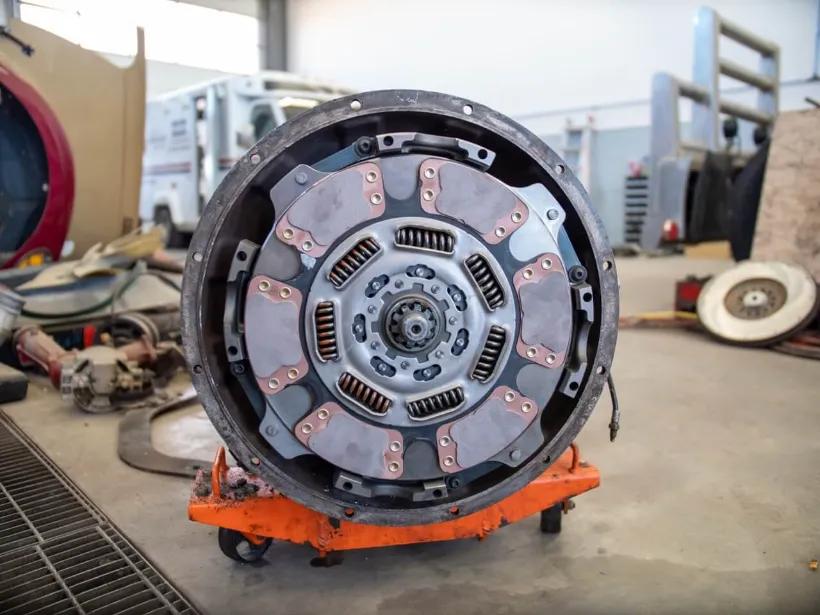What Are The Main Causes of Clutch Failure in Heavy-Duty Trucks?
Learn the top reasons clutches fail in heavy-duty trucks and how to prevent it. From driver habits to mechanical wear, we break it all down—especially for Fontana-based rigs.

When you're clocking mile after mile in a heavy-duty truck, your clutch is doing some serious work behind the scenes. It’s the linchpin between your engine and transmission, engaging and disengaging thousands of times over the course of a rig's life. But like anything mechanical, it’s got a breaking point—and when it goes, it goes.
So, let’s break down what typically causes clutch failure and what you can do to avoid getting stranded!
The Anatomy of a Heavy-Duty Truck Clutch
Before we explore the failures, it's worth knowing what’s under the hood. A typical manual transmission truck clutch system includes:
- Clutch disc
- Pressure plate
- Flywheel
- Release bearing
- Clutch pedal and linkage or hydraulics
These components work together to transfer or interrupt power from the engine to the transmission, which is crucial for gear changes and efficient driving.
1. Riding the Clutch – Operator Error
Driver habits are often the #1 culprit. “Riding the clutch,” or resting your foot on the pedal, keeps it partially engaged. This leads to excessive heat and friction, which prematurely wears down the clutch disc and pressure plate.
In urban settings like Fontana, where frequent stop-and-go traffic is common, this mistake can dramatically speed up wear.
Pro Tip: Train your drivers to keep that left foot off the pedal when not shifting. Better habits = longer clutch life.
2. Overloading the Truck
Heavy hauls are part of the job, but exceeding GVWR (Gross Vehicle Weight Rating) puts extra pressure on the drivetrain. A clutch designed for a specific torque range can only take so long before it slips or burns up.
What Happens?
Overloaded conditions cause the clutch to slip more frequently, generating excess heat and leading to glazing or even failure of the clutch plate.
3. Poor Clutch Adjustment
Manual clutches require periodic adjustment to maintain optimal free play in the pedal and prevent slipping or dragging. Too little free play means the clutch isn’t thoroughly engaging—causing constant friction. Too much, and the clutch won’t disengage completely, leading to gear grinding and hard shifts.
4. Oil or Hydraulic Fluid Contamination
If you’ve got a leaking rear main seal or transmission input shaft, you might end up with oil or hydraulic fluid on your clutch disc. That spells disaster. The fluid acts like a lubricant, causing the clutch to slip uncontrollably and burn out even faster.
Signs of contamination:
- Burning smell
- Slipping in high gear
- Sticky or unpredictable clutch engagement
5. Worn or Warped Flywheel
Your flywheel plays a big role in clutch engagement. When it's scored, heat-spotted, or warped, it prevents smooth engagement and increases wear on the clutch disc. Often, this is a side effect of the above issues—like overheating or overloading.
This can also lead to shuddering or chatter during the engagement, especially on incline-heavy routes.
6. Heat Damage from Frequent Stops
Frequent stopping and starting, like what you’d experience running loads in urban environments, causes constant clutch cycling. This builds up heat, especially in older clutches, which breaks down friction material over time.
Add southern California heat into the mix, and you have a perfect recipe for premature wear.
7. Failed Release Bearing or Clutch Fork
The release bearing and clutch fork are the unsung heroes of smooth disengagement. When they fail, whether due to a lack of lubrication, age, or mechanical binding, they stress every other component. The result? Incomplete disengagement and rapid wear.
8. Neglecting Preventive Maintenance
We can’t talk about clutch failure without hammering home the importance of preventive maintenance. According to the Diesel Repair Industry Handbook, failing to inspect and adjust clutch mechanisms regularly is one of the leading causes of system failure, this is why routine checks are crucial for uptime.
Warning Signs to Watch For
Catch a problem before it snowballs by watching for:
- Spongy or sticky clutch pedal
- Unusual noises during shifting
- Grinding gears
- A burning smell
- Loss of acceleration despite rising RPMs
Final Thoughts
From operator habits to mechanical wear and tear, clutch failure usually boils down to a mix of human error and skipped maintenance. By staying alert to the early signs and investing in quality clutch repair services, you can keep your fleet moving and your clutch out of the scrapyard!
More Articles
Contact OnSite Truck & Equipment Repair
Need roadside assistance, have questions, or want to schedule your truck or trailer in for service in Fontana, CA? Get in touch with OnSite Truck & Equipment Repair, we're open Monday through Friday from 7:00am to 4:00pm.

%20(2).webp)

.webp)